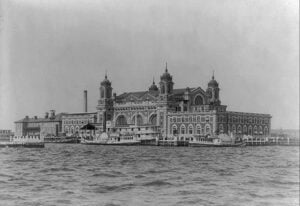In December, 1891 seventeen-year-old Annie Moore of County Cork, climbed aboard the USS Nevada, along with her two younger brothers, in Queensland, Ireland (now known as Cobh). On January 1, 1892 they disembarked to join their parents in New York, the first of seven hundred new immigrants to enter the United States through Ellis Island, formerly considered part of New York but declared by a judge, New Jersey-owned in 1998. By the year of its closure in 1954, more than twelve million more would follow Annie through the portals of the reception area to become United States citizens. The last was a Norwegian merchant-seaman named Arne Peterson.
In the years prior to 1892, New York City had processed immigrants through Castle Garden Immigration Depot, perhaps as many as eight million people. There were other ports of entry along the eastern and western seaboards, but the state system was collapsing when the Federal government took control of immigration in 1890. They consolidated the approved entryways and funneled the steerage passengers (1st and 2nd class could be processed aboard ship and disembark directly on Manhattan) through Ellis Island. They conducted a landfill project, doubling its size to six acres and constructed a processing station, which opened the first day of 1892.


The new immigrants came from all the nations of Europe, with noticeable increases from lands of Southern Europe and Russia. Approximately one million arrived every year from 1905-1912. In 1924 Congress passed the Immigration Act, greatly reducing the number of immigrants allowed in and moving much of the processing overseas at the U.S. embassies. They established quotas, seeking to reduce the number of people entering the United States, especially Jews, Italians, and Slavs from Southern and Eastern Europe. The American Eugenics movement played a role in persuading Congress to assist in keeping out people they considered defective or undesirable.
Part of the regular processing of new immigrants, culled from their ranks those with communicable diseases, those who were foreign criminals escaping law enforcement, and the obviously indigent who were not considered able-bodied or did not possess enough money to get a new start in the United States. A fairly rigorous medical inspection sent about 2% of the passengers back to their port of origin. About three thousand died in the Ellis Island hospital during the years of the Island’s operation. Estimates of the number of Americans descended from immigrants who passed through Ellis Island range up to one hundred million people.
After about thirty two years of operation, with the controversial Immigration Act, the use of Ellis Island as port of entry declined. By the 1930s it was used primarily for detention and deportation processing and for POWs of the Second World War. Today, a museum on the island interprets the history of immigration in the United States, especially as it relates to Ellis Island. While foreigners entering the United States to settle also occurred through other ports, Ellis Island has become the symbolic place for people fleeing persecution, poverty and hopelessness to seek a new life of freedom in the United States — to work hard and create a healthier and more prosperous future for their families.
Source: https://landmarkevents.org/ellis-island-immigration-station-opens-1892/




